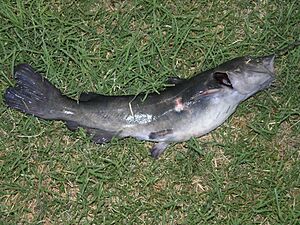Yaqui catfish facts for kids
Quick facts for kids Yaqui catfish |
|
|---|---|
 |
|
| Individual found dead near the San Bernardino National Wildlife Refuge | |
| Conservation status | |
| Scientific classification | |
| Synonyms | |
|
The Ictalurus pricei, also known as the Yaqui catfish, is a type of North American freshwater catfish. It lives in rivers and streams in Mexico and Arizona.
Contents
What Does the Yaqui Catfish Look Like?
The Yaqui catfish has a dark gray to black back. Its belly is white or grayish. The whiskers, called barbels, are usually jet-black. However, the barbels on its chin are gray or white.
This catfish often has many small spots on its body. You might also see a reddish color under its head. This reddish color can also be on its fins and tail. Adult Yaqui catfish can grow up to 57.0 centimetres (22.4 in) long. The spines on their fins are shorter than those of a similar-sized channel catfish (Ictalurus punctatus).
How Did It Get Its Name?
The Yaqui catfish, I. pricei, was named to honor William W. Price. He was likely a person important to its discovery or study.
Where Does the Yaqui Catfish Live?
Historically, the Yaqui catfish lived in San Bernardino Creek in Arizona. It was found as far up as San Bernardino Ranch. Some catfish were also moved to the Monkey Springs Reservoir system near Patagonia, Arizona. They lived there from 1899 until the 1950s.
These fish likely came from the Rio Sonora basin in Sonora, Mexico. The species still lives in that area today. In November 1997, about 350 Yaqui catfish were put back into the Rio Yaqui. This river is in the northern part of the San Bernardino National Wildlife Refuge.
What Kind of Home Does It Like?
Yaqui catfish mostly live in ponds or streams. They prefer larger rivers but can also be found in smaller streams. They like quiet, clear pools of water.
These catfish are most common in big rivers. They prefer areas with medium to slow currents. They also like sandy or rocky river bottoms. During the dry season, some streams may dry up. When this happens, the catfish find safe places in permanent pools. These pools are often fed by natural springs.
What's Happening to Their Numbers?
Yaqui catfish used to live well in San Bernardino Creek. But the creek started to dry up because people were pumping water from underground. This reduced the amount of water flowing in the creek. Also, too many farm animals walked through the creek. This damaged the habitat, making it hard for the catfish to live there.
In 1899, some catfish were moved to the Santa Cruz River system. They lived in a reservoir fed by Monkey Spring until the 1950s. In November 1997, a small group of 350 fish was put back into the Rio Yaqui. This was done in the northern part of the San Bernardino National Wildlife Refuge. However, outside this refuge, Yaqui catfish have disappeared from waters in the United States.
How Can We Help Yaqui Catfish?
Many things can harm Yaqui catfish populations. These include:
- Drying up habitats: When streams are used too much or water is moved away.
- Building dams: Creating barriers in streams.
- Changing river paths: Making streams straighter or narrower.
- Farm animals: Too much grazing by livestock near streams.
- Cutting down trees: Logging can affect water quality.
- Mining and road building: These activities can pollute or change habitats.
- Pollution: Dirtying the water.
- Introducing new fish: Bringing in fish that are not native to the area. These new fish can compete with or eat the Yaqui catfish.
Main Threats:
- Pumping too much water from underground.
- Less water flowing in streams.
- Moving water away from streams.
- Droughts (long periods without rain).
- Mixing with other fish species.
- Competition and being eaten by fish that are not native.
What We Need to Do to Help:
- Protect the underground water sources (aquifers) in San Bernardino.
- Protect Leslie Creek and Black Draw watersheds. This helps make sure there's always enough water flowing.
- Reduce the bad effects of non-native fish.
- Put Yaqui catfish back into suitable places where they used to live.
- Help the populations in Mexico become stable and protected.



